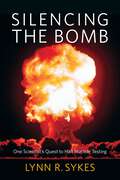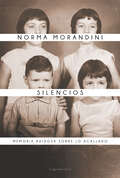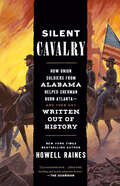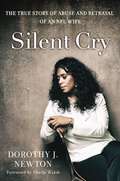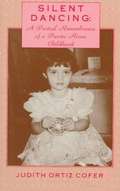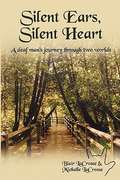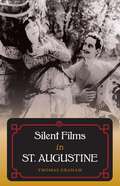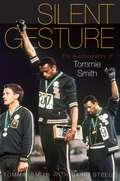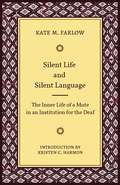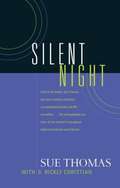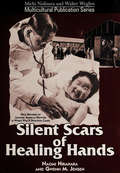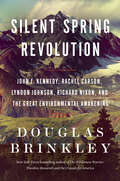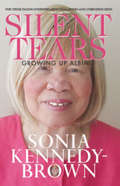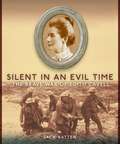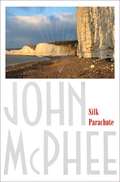- Table View
- List View
Silencing the Bomb: One Scientist's Quest to Halt Nuclear Testing
by Lynn R. SykesIn December 2016, the Bulletin of Atomic Scientists moved their iconic “Doomsday Clock” thirty seconds forward to two and a half minutes to midnight, the latest it has been set since 1952, the year of the first United States hydrogen bomb test. But a group of scientists—geologists, engineers, and physicists—has been fighting to turn back the clock. Since the dawn of the Cold War, they have advocated a halt to nuclear testing, their work culminating in the Comprehensive Test Ban Treaty, which still awaits ratification from China, Iran, North Korea—and the United States. The backbone of the treaty is every nation’s ability to independently monitor the nuclear activity of the others. The noted seismologist Lynn R. Sykes, one of the central figures in the development of the science and technology used in monitoring, has dedicated his career to halting nuclear testing. In Silencing the Bomb, he tells the inside story behind scientists’ quest for disarmament.Called upon time and again to testify before Congress and to inform the public, Sykes and his colleagues were, for much of the Cold War, among the only people on earth able to say with certainty when and where a bomb was tested and how large it was. Methods of measuring earthquakes, researchers realized, could also detect underground nuclear explosions. When politicians on both sides of the Iron Curtain attempted to sidestep disarmament or test ban treaties, Sykes was able to deploy the nascent science of plate tectonics to reveal the truth. Seismologists’ discoveries helped bring about treaties limiting nuclear testing, but it was their activism that played a key role in the effort for peace. Full of intrigue, international politics, and hard science used for the global good, Silencing the Bomb is a timely and necessary chronicle of one scientist’s efforts to keep the clock from striking midnight.
Silencing the Voices: One Woman's Triumph Over Multiple Personality Disorder
by Jean Darby ClineJEAN is a dutiful wife who will do anything to make her marriage work. But JODY hates Jean's husband and is determined to drive them apart. Little JD just hides from it all, emerging only when Jean's painful past is more than she can bear. These are the voices that live within the mind of Jean Darby Cline. As a child, Jean suffered unspeakable mental and sexual abuse at the hands of her father. As an adult, her first husband's verbal abuse and cruel outbursts of rage echoed the violence of her childhood. Jean hoped that psychotherapy would help ease her depression-and fill in the major lapses of her memory. Instead, Jean made a startling discovery. The childhood horrors she'd endured had caused her personality to fragment into three separate entities-three people with opinions and emotions all their own...
Silencios: Memoria ruidosa sobre lo acallado
by Norma MorandiniEl repliegue en tiempos del terror ideológico y el confinamiento en cuarentena, el "olvido" de las violaciones en los centros clandestinos y las marchas por María Soledad en una sociedad amordazada, las ruidosas movilizaciones del #NiUnaMenos y el congelamiento de la ESMA como relato para silenciar el debate sobre la memoria trágica. Una honesta y dolorosa narración autobiográfica que deviene historia colectiva. «Hay una enseñanza ética en la obstinación de Norma Morandini en distinguir entre el dolor personal y la historia colectiva, la cólera y la venganza. Y una semilla de esperanza: el abrazo de un encuentro casual, los diálogos sinceros entre enemigos del pasado que ahora saben escucharse y respetarse. Lo que hace de este pequeño libro un gran aporte a la democracia de los argentinos».Loris Zanatta
Silent Cavalry: How Union Soldiers from Alabama Helped Sherman Burn Atlanta--and Then Got Written Out of History
by Howell RainesA Pulitzer Prize–winning journalist reveals the little-known story of the Union soldiers from Alabama who played a decisive role in the Civil War, and how they were scrubbed from the history books.&“It is my sincere hope that this compelling and submerged history is integrated into our understanding of our nation, and allows us to embrace new heroes of the past.&”—Imani Perry, professor, Harvard University, and National Book Award–winning author of South to AmericaWe all know how the Civil War was won: Courageous Yankees triumphed over the South. But is there more to the story?As Pulitzer Prize–winning journalist Howell Raines shows, it was not only soldiers from northern states who helped General William Tecumseh Sherman burn Atlanta to the ground but also an unsung regiment of 2,066 Alabamian yeoman farmers—including at least one member of Raines&’s own family.Called the First Alabama Cavalry, U.S.A., this regiment of mountain Unionists, which included sixteen formerly enslaved Black men, was the point of the spear that Sherman drove through the heart of the Confederacy. The famed general hailed their skills and courage. So why don&’t we know anything about them?Silent Cavalry is part epic American history, part family saga, and part scholarly detective story. Drawing on the lore of his native Alabama and investigative skills honed by six decades in journalism, Raines brings to light a conspiracy that sought to undermine the accomplishments of these renegade southerners—a key component of the Lost Cause effort to restore glory to white southerners after the war, even at the cost of the truth.In this important new contribution to our understanding of the Civil War and its legacy, Raines tells the thrilling tale of the formation of the First Alabama while exposing the tangled web of how its wartime accomplishments were silenced, implicating everyone from a former Confederate general to a gaggle of Lost Cause historians in the Ivy League and a sanctimonious former keeper of the Alabama state archives. By reversing the erasure of the First Alabama, Silent Cavalry is a testament to the immense power of historians to destroy as well as to redeem.
Silent Cry: The True Story of Abuse and Betrayal of an NFL Wife
by Dorothy J. NewtonRaised near New Orleans as one of six children, Dorothy Newton was surrounded by abuse and poverty as she grew up. But she became the first in her family to graduate from college and moved out of poverty. She then began to live out her dreams in Dallas of a better home and life when she married celebrity superstar football player Nate Newton. She had gone from poverty to the pinnacle of success. She was married to a handsome, successful, famous professional athlete, who was a three time Super Bowl Champion and six time Pro-Bowler for the Dallas Cowboys.But all that glittered was not gold.Before long the relationship turned abusive. She found herself living in the world she thought she had escaped in her years growing up. The world did not see her suffering behind closed doors—she was betrayed, treated abusively, threatened continually. Dorothy was trapped with no one to talk to and nowhere to run. In this book Dorothy shares her experiences of pain, loss, survival, hope, recovery, and victory. A gripping story throughout, A Silent Cry is a testament to Dorothy&’s will to live and the peace that comes with hope in the God who sees and hears your tears—even when no one else does.
Silent Dancing: A Partial Remembrance of a Puerto Rican Childhood
by Judith Ortiz CoferSilent Dancing is about a young girl as she struggles through life, constantly being moved from the U.S. to Puerto Rico, and back again.
Silent Days, Silent Dreams
by Allen SayCaldecott Medal winner Allen Say brings his lavish illustrations and hybrid narrative and artistic styles to the story of artist James Castle.James Castle was born two months premature on September 25, 1899, on a farm in Garden Valley, Idaho. He was deaf, mute, autistic, and probably dyslexic. He didn't walk until he was four; he would never learn to speak, write, read, or use sign language.Yet, today Castle's artwork hangs in major museums throughout the world. The Philadelphia Museum of Art opened "James Castle: A Retrospective" in 2008. The 2013 Venice Biennale included eleven works by Castle in the feature exhibition "The Encyclopedic Palace." And his reputation continues to grow.Caldecott Medal winner Allen Say, author of the acclaimed memoir Drawing from Memory, takes readers through an imagined look at Castle's childhood, allows them to experience his emergence as an artist despite the overwhelming difficulties he faced, and ultimately reveals the triumphs that he would go on toachieve.
Silent Ears, Silent Heart: A Deaf Man's Journey Through Two Worlds
by Blair Lacrosse Michelle LacrosseAccording to the National Center for Health Statistics of the U. S. Department of Health and Human Services, approximately 34 million Americans have a significant hearing loss; of these almost six million are profoundly deaf. Imagine living in a world where everyone around you speaks a different language, and you cant master it . . . The culture of those around you is different from your own, but you cant be a part of it . . . No matter how much you struggle to fit in, you never will. And what if this is your lot in life not by choice but by chance. How would you feel? This is the very same world into which millions of deaf persons are born, including Christopher Cline. Christophers journey through life highlights the challenges that a deaf individual growing up in a hearing world faces on a daily basis, including the most difficult, yet most important, challenge of all gaining the acceptance and approval of ones hearing parents. Silent Ears, Silent Heart gives the reader a glimpse into the language, culture, and life of a deaf person, but it does more than that. The readers heart becomes intertwined with Christophers so that he or she is inspired to be empathetic toward the plight of deaf individuals.
Silent Films in St. Augustine
by Thomas Graham“This absorbing tale, documenting the forgotten history of early moviemaking in St. Augustine, is a must-read for film enthusiasts.”—Janelle Blankenship , coeditor of European Visions: Small Cinemas in Transition “Very few people have any idea that St. Augustine played any role in early film history. This book brings St. Augustine into a much larger film conversation.”—Christina Lane, author of Magnolia “This richly detailed book tells the story of early filmmakers’ adventures in St. Augustine and captures the excitement of their moviemaking escapades.”—Kathryn Fuller-Seeley, coauthor of One Thousand Nights at the Movies: An Illustrated History of Motion Pictures, 1895–1915 “Given that the great majority of these early films are now lost, Graham makes an important contribution to the study of Florida’s image on film.”—Jan-Christopher Horak, author of Saul Bass: Anatomy of Film Design “The ‘reel’ history of Florida and its contribution to the development of American film history has been left out of mainstream textbooks and accounts. Thomas Graham’s book is a link in the chain of that history and an important addition to film scholarship.”—Susan Doll, coauthor of Florida on Film: The Essential Guide to Sunshine State Cinema and Locations “Through entertaining stories of how St. Augustine lured studios and enriched filmmaking with Henry Flagler’s railroad and architecture, Graham adds new detail to our understanding of the silent film era.”—Rita Reagan, Norman Studios Silent Film Museum Before Hollywood, when America’s rising motion picture industry was based on the East Coast, early film stars like Rudolph Valentino, Thomas Meighan, Ethel Barrymore, and Oliver Hardy made movies in St. Augustine, Florida. Silent Films in St. Augustine tells stories of the leading film producers and actors who escaped New York winters—and kept the studio doors open—in St. Augustine’s sunshine and warm weather. Scenes for more than 120 films were made in St. Augustine from 1906 to 1926 by film companies including Thanhouser, Lubin, Éclair, Pathé, Edison, Vitagraph, and Paramount. The first feature-length Frankenstein movie, Life Without Soul, was partly shot in St. Augustine. Theda Bara became a “vamp” sensation for her role in A Fool There Was. Sidney Drew acted in the genderbending A Florida Enchantment. Noted directors Edwin S. Porter, Maurice Tourneur, and George Fitzmaurice also set up shop in the beach town. Filmmakers used St. Augustine’s striking architecture to create backdrops for movies set in exotic foreign locales. The famous Castillo de San Marcos, the stone houses on the narrow streets, and Henry Flagler’s Spanish Renaissance palace hotels were reimagined as Spain, Italy, France, Egypt, Arabia, South Africa, Brazil, and Hawaii. Residents of St. Augustine loved seeing film teams in action on their streets and would gather around the camera to watch the actors and marvel at the outlandish costumes. Cast as extras in larger productions, locals packed theater houses to catch a glimpse of themselves and their neighbors on the screen. Describing the lavish sets, theatrical action, and New York movie personalities that filled St. Augustine, Thomas Graham evokes an intensely creative time and place in the history of American moviemaking.
Silent Gesture: The Autobiography of Tommie Smith
by Tommie Smith David SteeleIn 1968, Tommie Smith and his teammate John Carlos won the gold and silver medals, respectively, for the 200 meter dash. Receiving their medals on the dais, they raised their fists and froze a moment in time that will forever be remembered as a powerful day of protest. In this, his autobiography, Smith tells the story of that moment, and of his life before and after it, to explain what that moment meant to him. In Silent Gesture, Smith recounts his life before and after the 1968 Olympics: his life-long commitment to athletics, education, and human rights. He dispels some of the myths surrounding his and Carlos' act on the dais -- contrary to legend, Smith wasn't a member of the Black Panthers, but a member of the US Olympic Project for Human Rights -- and describes in detail the planning and risks involved in his protest. Smith also details his many years after Mexico City of devotion to human rights, athletics, and education. A unique resource for anyone concerned with international sports, history, and the African American experience, Silent Gesture contributes a complete picture of one of the most famous moments in sports history, and of a man whose actions always matched his words.
Silent Invasion: The Untold Story of the Trump Administration, Covid-19, and Preventing the Next Pandemic Before It's Too Late
by Deborah BirxThe definitive, inside account of the Trump Administration’s response to the Covid-19 pandemic from White House Coronavirus Response Coordinator and Coronavirus Task Force member, Dr. Deborah Birx.In late February 2020, Dr. Deborah Birx—a lifelong federal health official who had worked at the CDC, the State Department, and the US Army across multiple presidential administrations—was asked to join the Trump White House Coronavirus Task Force and assist the already faltering federal response to the Covid-19 pandemic. For weeks, she’d been raising the alarm behind the scenes about what she saw happening in public—from the apparent lack of urgency at the White House to the routine downplaying of the risks to Americans. Once in the White House, she was tasked with helping fix the broken federal approach and making President Trump see the danger this virus posed to all of us.Silent Invasion is the story of what she witnessed and lived for the next year—an eye-opening, inside account, detailed here for the first time, of the Trump Administration’s response to the greatest public health crisis in modern times. Regarded with suspicion in the West Wing from day one, Dr. Birx goes beyond the media speculation and political maneuvering to show what she was really up against in the Trump White House. Digging into the hard-fought victories, the costly mistakes, and the human drama surrounding the administration’s efforts, she examines the forces that crippled efforts to control the virus and explores why these blunders continue to haunt us today.And yet amid the agonizing missteps were bright spots that point the way forward—the fastest vaccine creation in history, governors that put their citizens’ health first, and Tribal Nations that demonstrated the powerful role of community in curbing spread, despite their criminally underfunded healthcare systems. Collectively these successes reveal the valiant work of many who were committed to saving lives, as well as highlighting the dire need to reform our public health institutions, so they are nimble and resilient enough to confront the next pandemic.With the pandemic now moving into its third year confounding two presidential administrations, Dr. Birx presents a story at once urgent and frustratingly unfinished, as Covid-19 continues to put thousands of American lives at risk. The end result is the most comprehensive and extensive accounting to date of the Trump Administration’s struggle to control the biggest health crisis in generations—a revelatory look at how we can learn from our mistakes and prevent this from happening again.
Silent Life and Silent Language: The Inner Life of a Mute in an Institution for the Deaf (Gallaudet Classics Deaf Studie #11)
by Kristen C. Harmon Kate M. FarlowSilent Life and Silent Language presents a fictionalized account of life at a Midwestern residential school for deaf students in the years following the Civil War. Based on the experiences of the author, who became deaf at the age of nine and entered a residential school when she was twelve, this historical work is remarkable and rare because it focuses on signing deaf women’s lives. One of only a few accounts written by deaf women in the 19th century, Silent Life and Silent Language gives a detailed description of daily life and learning at the Indiana Asylum for the Education of the Deaf and Dumb. Kate M. Farlow wrote this book with the goal of giving hearing parents hope that their deaf children would be able to lead happy and productive lives. She sought to raise awareness of the benefits of deaf schools and was an early advocate for the use of American Sign Language and of bilingual education. The Christian influence on the school and on the author is strongly present in her writing and reflects an important component of deaf education at the time. Descriptions of specific signs, games, ASL story nights, and other aspects of the signing community during the 1870s will be of interest to modern students and researchers in linguistics, deaf education, Deaf studies, and Deaf history. Farlow’s work reveals a sophisticated, early understanding of the importance of access to language, education, and community for deaf individuals.
Silent Night
by Sue Thomas<P>Some people may have considered Sue Thomas's deafness a liability. The FBI considered it an asset.... <P>Growing up in northeastern Ohio, Sue Thomas was like any other toddler. But one evening while watching television with her family, suddenly she couldn't hear the sound of the program. The next morning Sue didn't respond to anyone's voice. Her parents rushed her to their family doctor. He delivered devastating news: eighteen month-old Sue had experienced a sudden and total hearing loss. <P>Sue's parents made a lifelong commitment to help her live as normal a life as possible in the hearing world. With professional assistance, Sue learned to speak and lip read. When school presented challenges, Sue worked harder, eventually earning a B. S. degree and completing graduate work in political science and international relations. <P>A door opened at the FBI for Sue to begin a training program for deaf people to classify fingerprints. But when agents realized Sue's uncanny ability to read lips, they approached her about undercover surveillance. Sue excelled at her job, exceeding her family's expectations. <P>Yet something still seemed to be missing in her life. Refocusing her goals on helping others, today Sue is a motivational speaker with a deeper purpose who appears regularly before civic, professional, and church groups. Silent Night tells her inspiring story.
Silent No More: Victim 1's Fight for Justice Against Jerry Sandusky
by Michael Gillum Dawn Daniels Aaron FisherVictim 1, at fourteen years of age, spoke up against Jerry Sandusky in the Penn State scandal, and now for the first time tells his story.Aaron Fisher was an eager and spirited eleven-year-old when legendary Penn State football coach Jerry Sandusky recruited him into his Second Mile children's charity. Offering support at a critical time in Aaron's life, Sandusky gave him gifts and attention, winning the boy's trust even as he isolated him from his family and peers. Before long, Sandusky's attention escalated into sexual assault. When Aaron summoned the courage to speak up, he found himself ostracized and harassed by the very people who were supposed to protect him. The investigation set off by his coming forward would drag on for three years--and would launch the biggest scandal in the history of sports.In Silent No More, Aaron Fisher recounts his harrowing quest to bring Sandusky's crimes to light--from the intense feelings of guilt that kept him from speaking up earlier and the fear he felt at accusing a man who was a pillar of the community and a hero to the largest alumni network in the world, to the infuriating delays in the arrest and conviction of his abuser. He catalogs the devastating personal toll the case took on him: the shattered relationships, panic attacks, and betrayal of trust that continued to haunt him even after the charges went public in the fall of 2011. But he also speaks of his mother's desperate efforts to get him out of harm's way, the invaluable help of psychologist Michael Gillum, and the vindication he felt at inspiring numerous other victims to step forward . . . and at knowing that, thanks to him, there would be no future victims of Jerry Sandusky.In the end, Aaron Fisher won his fight to expose the truth, achieving some measure of closure. Told in the honest and unforgettable voices of Aaron; his mother, Dawn; and his psychologist, Mike, this inspiring book completes Aaron's transformation from a nameless casualty into a resounding voice for change.From the Hardcover edition.
Silent Observer (Awareness And Caring Ser.awareness & Caring - Sign Language)
by Christy MacKinnonRendered in lovely, full-color illustrations, Silent Observer traces the early life of author Christy MacKinnon in Nova Scotia at the turn of the century. Born in 1889, the author lost her hearing from “the Winter fever” at the age of two. Her story tells of a simple, charming life on her family’s farm by the bay and in the schoolhouse where her father taught her in their hometown of Boisdale. Silent Observer is an affectionate, poignant memoir of childhood as seen through the eyes of a vivacious young girl. Teachers, parents, and children will share in their enjoyment of this beautiful, sensitive story of a harder but wonderful time that has passed.
Silent Partner: A Memoir of My Marriage
by Dina Matos McGreeveyThe truth behind the lies.It was an unforgettable scene. Dina Matos McGreevey, an attractive woman in her mid-thirties, wife, mother, and First Lady of the state of New Jersey, watched silently as her husband, then New Jersey Governor Jim McGreevey, resigned his office with the revelation that he was a "gay American." The picture of grace and loyalty, perfectly composed in her pale blue suit, Dina Matos McGreevey gave no sign of the tangled mixture of fear, sorrow, and anger she felt that day, no hint of the devastation that was to come. Since then she has been asked repeatedly about the nature of her marriage, about what she knew and when she knew it. Since then, she has remained silent. Until now.Speaking up at last, Dina Matos McGreevey here recounts the details of her marriage to Jim McGreevey. What emerges is a tale of love and betrayal, of heartbreak and scandal . . . and, ultimately, hope.It all began with so much promise. Dina Matos was a responsible and civic-minded young woman who fell in love with the passion of political action. When Jim McGreevey walked into her life, he appeared to be a kind and loving man, someone with whom she could build a life based on shared ideals, a strong spiritual commitment, and a desire to make a difference in the world. Beyond their initial chemistry, Dina Matos was attracted by Jim McGreevey's principles and his unwavering devotion to his work. She didn't know that his life, and thus their marriage, were built on a foundation of lies; that his past was littered with casual sexual encounters in seedy bookstores and public parks; or that, by his own admission, he began an adulterous affair with another man while she was in the hospital awaiting the birth of their child. "Could I have known," she asks. "How could I have known?"With scalding honesty, she tells of her life with the former governor, of the politics and public service that brought them together, and the lies that tore them apart.Here is a story of a marriage that was anything but happily-ever-after, told by a strong and resilient woman who can, and finally will, speak for herself.
Silent Scars of Healing Hands: Oral Histories of Japanese American Doctors in World War II Detention Camps (Michi Nishiura and Walter Weglyn Multicultural Publication Series)
by Naomi Hirahara Gwenn JensenOn February 19, 1942, by order of President Franklin D. Roosevelt, all Nikkei (American born Japanese American citizens) were subject to an indiscriminate and mass incarceration that affected more than 110,000 people. Within weeks, Issei and Nisei doctors found themselves vaccinating long lines of people in anticipation of their imminent removal from homes and businesses. Cast into temporary detention, these same physicians struggled to open clinics and treat patients in facilities ill prepared for the onslaught of families, pregnant, women, elderly, and toddlers. This book is their story -- a collection of oral histories of Nisei physicians who directed health care behind barbed wires.
Silent Spring Revolution: John F. Kennedy, Rachel Carson, Lyndon Johnson, Richard Nixon, and the Great Environmental Awakening
by Douglas BrinkleyNew York Times bestselling author and acclaimed presidential historian Douglas Brinkley chronicles the rise of environmental activism during the Long Sixties (1960-1973), telling the story of an indomitable generation that saved the natural world under the leadership of John F. Kennedy, Lyndon Johnson, and Richard Nixon.With the detonation of the Trinity explosion in the New Mexico desert in 1945, the United States took control of Earth’s destiny for the first time. After the Truman administration dropped atomic bombs on Japan to end World War II, a grim new epoch had arrived. During the early Cold War years, the federal government routinely detonated nuclear devices in the Nevada desert and the Marshall Islands. Not only was nuclear fallout a public health menace, but entire ecosystems were contaminated with radioactive materials. During the 1950s, an unprecedented postwar economic boom took hold, with America becoming the world’s leading hyperindustrial and military giant. But with this historic prosperity came a heavy cost: oceans began to die, wilderness vanished, the insecticide DDT poisoned ecosystems, wildlife perished, and chronic smog blighted major cities. In Silent Spring Revolution, Douglas Brinkley pays tribute to those who combated the mauling of the natural world in the Long Sixties: Rachel Carson (a marine biologist and author), David Brower (director of the Sierra Club), Barry Commoner (an environmental justice advocate), Coretta Scott King (an antinuclear activist), Stewart Udall (the secretary of the interior), William O. Douglas (Supreme Court justice), Cesar Chavez (a labor organizer), and other crusaders are profiled with verve and insight. Carson’s book Silent Spring, published in 1962, depicted how detrimental DDT was to living creatures. The exposé launched an ecological revolution that inspired such landmark legislation as the Wilderness Act (1964), the Clean Air Acts (1963 and 1970), and the Endangered Species Acts (1966, 1969, and 1973). In intimate detail, Brinkley extrapolates on such epic events as the Donora (Pennsylvania) smog incident, JFK’s Limited Nuclear Test Ban Treaty, Great Lakes preservation, the Santa Barbara oil spill, and the first Earth Day.With the United States grappling with climate change and resource exhaustion, Douglas Brinkley’s meticulously researched and deftly written Silent Spring Revolution reminds us that a new generation of twenty-first-century environmentalists can save the planet from ruin.Silent Spring Revolution features two 8-page color photo inserts.
Silent Star: The Story of Deaf Major Leaguer William Hoy
by William WiseThe biography of William Ellsworth Hoy, the first deaf player to have a successful career in professional and Major League baseball.William Hoy loved baseball. Growing up in the 1860s and '70s, he dreamed of one day playing in the major leagues. A far-off fantasy for many boys, fulfilling this dream was even more of a long shot for William, who was deaf. Striving to find his place in a hearing world, Hoy became a shoemaker. He took pride in his work, but baseball was still his real love. When an amateur team coach saw him playing behind the shoemaker's shop, Hoy dazzled the coach with his hard-hitting skills. Moving from amateur clubs to the minor leagues and eventually to the majors, Hoy proved himself again and again-overcoming obstacles and becoming a star both on and off the baseball diamond. Silent Star: The Story of Deaf Major Leaguer William Hoy is a tribute to one of the most inspirational figures in baseball history. A talented player with a standout record, Hoy is a shining example that success in life should not be measured by differences but by drive and determination.
Silent Tears: Growing Up Albino
by Sonia Kennedy-Brown<p>Sonia Kennedy-Brown, an albino and a native of Jamaica, is a Canadian citizen. She is a Registered Nurse (RN) with a Bachelor of Science degree from Northern Caribbean University (then West Indies College) in Jamaica and a Master’s in educational psychology from Andrews University in the United States. She has been a nurse and nursing educator, and is a church leader and public speaker. <p>Growing up albino was for her about as painful an experience as a young person could endure. The physical disadvantages range from skin problems to visual impairment. But greater are the emotional pain and social impediments. Many people in her community could not see the beauty that was there, only the pigment that was not. Prepare to enjoy <i>Silent Tears: Growing Up Albino</i>—Sonia’s story of suffering and recovery.</p>
Silent Witness: The Untold Story of Terri Schiavo's Death
by Mark FuhrmanWe all watched Terri Schiavo die. The controversy around her case dominated the headlines and talk shows, going all the way to the U.S. Supreme Court, the White House, and the Vatican. And it's not over yet. Despite her death, the controversy lingers. In Silent Witness, former LAPD detective and New York Times bestselling author Mark Fuhrman applies his highly respected investigative skills to examine the medical evidence, legal case files, and police records. With the complete cooperation of Terri Schiavo's parents and siblings, as well as their medical and legal advisers, he conducts exclusive interviews with forensics experts and crucial witnesses, including friends, family members, and caregivers. Fuhrman's findings will answer these questions: What was Terri and Michael Schiavo's marriage really like? What happened the day Terri collapsed? What did Michael Schiavo do when he discovered Terri unconscious? How long did he wait before calling 911? What do medical records show about her condition when she was first admitted to the hospital? What will the autopsy say? The legal issues and ethical questions provoked by Terri Schiavo's extraordinary case may never be resolved. But the facts about her marriage, her condition when she collapsed, and her eventual death fifteen years later can be determined. With Silent Witness, Fuhrman goes beyond the legal aspects of the case and delves into the broader, human background of Terri Schiavo's short, sad life.
Silent Witness: The Untold Story of Terri Schiavo's Death
by Mark FuhrmanWe all watched Terri Schiavo die. The controversy around her case dominated the headlines and talk shows, going all the way to the U.S. Supreme Court, the White House, and the Vatican.And it's not over yet. Despite her death, the controversy lingers. In Silent Witness, former LAPD detective and New York Times bestselling author Mark Fuhrman applies his highly respected investigative skills to examine the medical evidence, legal case files, and police records. With the complete cooperation of Terri Schiavo's parents and siblings, as well as their medical and legal advisers, he conducts exclusive interviews with forensics experts and crucial witnesses, including friends, family members, and caregivers.Fuhrman's findings will answer these questions:What was Terri and Michael Schiavo's marriage really like?What happened the day Terri collapsed?What did Michael Schiavo do when he discovered Terri unconscious? How long did he wait before calling 911?What do medical records show about her condition when she was first admitted to the hospital?What will the autopsy say?The legal issues and ethical questions provoked by Terri Schiavo's extraordinary case may never be resolved. But the facts about her marriage, her condition when she collapsed, and her eventual death fifteen years later can be determined.With Silent Witness, Fuhrman goes beyond the legal aspects of the case and delves into the broader, human background of Terri Schiavo's short, sad life.
Silent and Unseen
by Alfred Scott MclarenIn Silent and Unseen, veteran submarine commander Captain Alfred S. McLaren describes in riveting detail the more significant events that occurred early in the Cold War during his seven years, 1958-1965, onboard three attack submarines: the USS Greenfish (SS-351), USS Seadragon (SSN-584), and USS Skipjack (SSN-585). Through myriad stories and anecdotes, his book focuses on the development of attack-boat tactics and under-ice exploration techniques. The commanding officers that a young submarine officer serves with will determine how well prepared he will be to assume his own command years later. This was particularly true in attack submarines, during the early high-risk years of the Cold War. They were continually at sea, and each reconnaissance and intelligence collection mission was of potentially great, and sometimes extraordinary, value to the government of the United States of America. The missions more often than not required closing of the potential enemy to collect the intelligence desired, generally within weapons range. But, unlike a war patrol, the U. S. attack boat had to remain completely undetected; then withdraw as silently and unseen as it approached. Greenfish was one of the most successful Pacific diesel submarines when McLaren served aboard her as a watch and weapons officer during an era when she and other diesel boats executed all Cold War missions and overseas deployments. McLaren then reported to Seadragon in time to serve as a watch officer, as she became the first nuclear submarine to transit from the Atlantic to the Pacific via the Arctic Ocean. En route, she examined the underside of icebergs, conducted the first underwater survey and passage through the Northwest Passage, and surfaced at the North Pole. He subsequently served as diving officer, an engineering department division officer and as weapons officer during a series of Cold War missions and a lengthy Western Pacific deployment. Silent and Unseen concludes with a recounting of the author’s experiences as diving officer, navigator, and chief engineer onboard what was then world’s fastest and most advanced submarine, USS Skipjack (SSN-585) during the Cuban Missile Crisis, two Cold War missions, and the very intensive and exciting period of new tactical and weapons development which followed to counter a rapidly emerging Soviet nuclear submarine threat
Silent in an Evil Time: The Brave War of Edith Cavell
by Jack BattenDutiful nurse, hospital matron, courageous resistance fighter, Edith Cavell was all of these. A British citizen, the forty-eight-year-old Cavell was matron of an institute for nurses in the suburbs of Brussels at the outbreak of World War I. Dedicated to the methods of Florence Nightingale, her intelligence and ferocious sense of duty had transformed the institute into a leading training center.When the Germans captured Belgium in the fall of 1914, an organization was formed to assist British and French soldiers trapped behind German lines. Edith was asked to help and she didn't hesitate. From that moment forward, Edith sheltered escaping soldiers in her hospital, using trickery to keep the suspicious Germans from discovering them. She helped arrange a secret route to neutral Holland and back to England at great personal risk, enabling soldiers of all ranks to slip through German lines. Using the institute as part of an elaborate Allied escape route, Edith Cavell was responsible for one thousand soldiers eventually making their way home.But Cavell's role was discovered and a German military court put her on trial in Brussels, where she was sentenced to be executed by firing squad. On October 12, 1915, she put on her nurse's uniform and met her fate, immediately becoming a worldwide martyr and rallying point for the British in their war against Germany.In this riveting account, author Jack Batten brings an incredibly brave woman and her turbulent times to life.From the Trade Paperback edition.
Silk Parachute
by John McpheeJohn Mcphee's most recent collection of short to medium-length essays first printed in "The New Yorker". The collection is unusual in that it contains several highly personal essays recounting episodes in his own life, including the title piece, "Silk Parachute".
